Ijraset Journal For Research in Applied Science and Engineering Technology
- Home / Ijraset
- On This Page
- Abstract
- Introduction
- Conclusion
- References
- Copyright
Anant Sanskaran-A Solution for Lost Cultural Heritage of India
Authors: Ms. Shivangi Sharma, Ankit Pandey, Mukul Dubey, Shivam Amarghade, Shrut Jain, Namira Qureshi, Nancy Tripathi
DOI Link: https://doi.org/10.22214/ijraset.2024.65952
Certificate: View Certificate
Abstract
Indian culture is an intricate tapestry woven from centuries of diverse traditions, languages, and beliefs. This rich heritage encompasses a myriad of practices, festivals, art forms, and philosophies that have evolved over millennia. The Indian culture as a whole is multiethnic as it constitutes different religions. Festivals and celebrations are an integral part of the Indian way of life, they are often associated with seasons, agriculture, and the way of religion. People delight in the celebration of such holidays as Diwali, Holi, Eid, Christmas, and Pongal as they signify change and love to the families and communities of the people celebrating them. These are occasions that call for harmony, respect, and tolerance over the diversity in the people. In addition, Indian art has its classical dances such as Bharatanatyam, Kathak, and Odissi as well as crafts in painting, pottery, and weaving art. The architecture of India, exemplified by monumental structures like the Taj Mahal, ancient temples, and forts, is a testament to the country\'s historical evolution and artistic ingenuity Philosophical and literary traditions have also flourished, with ancient texts like the Vedas and Upanishads laying the foundation for spiritual and intellectual thought. Indian literature, both classical and contemporary, has enriched global narratives, exploring complex themes of love, morality, and human experience. Though India’s culture and heritage landscape is vast, some states and cities remain bereft of even the bare minimum exposure and appreciation for their historical, cultural, and specific variants of art. This effort is aimed at promoting and exposing the cultural identities of the Indian states and the cities that are usually not given prominence. It will thus assist in contextualizing the rich history, the geography of the regions, and the peoples inhabiting them through images, videos, and sounds. It will also include virtual tours, catalogues of archival materials, storytelling, and many other types of media on the regional arts, crafts, festivals, traditions, and historical places. The website is intended to be a one-stop place for recording, archiving, and promoting the culture of the region\'s heritage both the intangible and the tangible. It will include virtual tours, multimedia content, archival resources, and interactive storytelling about regional arts, crafts, festivals, folklore, and colonial- era landmarks This approach aims to utilize these regions, create awareness about them, and guarantee that their culture is wholly protected and appreciated and is internationally prominent. Using this internet project, we can also attack the problem of recognition of heritage and encourage appreciation of the glorious and varied past of Indian culture.
Introduction
I. INTRODUCTION OF PROJECT DESCRIPTION
A. Discover India’s timeless cultural heritage
Welcome to the essence of India. Immerse yourself in the cultural tapestry of India, as we take you on a tour through the best that this country has to offer. Witness inspirational stories, breathtaking visuals and our unique outlook on celebrating heritage.
Discover our legacy! History — if it fascinates you; if culture — flows in your veins; if exploring — is your way of life or even if curiosity just defines you… here's your destination for experiencing an emotion called INDIA!
B. Problem of Indian Culture
India's affluent cultural heritage faces threats from urbanization, lack of vigilance, and inadequate digitization, leading to the loss of traditional practices and underrepresentation of unique regional cultures. Younger generations are increasingly disconnected from their roots due to modern influences. Nevertheless, there remain several states that practice such distinct traditions and not including them allows for the rare cultural heritage that is related to them to be viewed by either a national or an international audience.
C. Objectives of Websites
To develop an inclusive digital platform that provides equal representation to the cultural and heritage aspects of all Indian states and cities, including those often overlooked, by leveraging multimedia content. The platform aims to Promote Awareness, preserve traditions, foster engagement, bridge gaps, encourage participation, global outreach. Circle Wise Number of Domestic Visitor to Centrally Protected Ticketed Monuments in India (2022 to 2024)
The above table shows data of revenue collected from 2022 to 2024 through tourism.
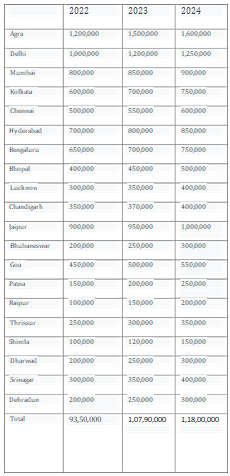
D. What the Website Offers
The website is a comprehensive platform designed to highlight and promote the diverse cultural heritage through interactive tools such as quizzes, virtual tours, and maps. It will also feature unique traditions, arts, festivals, and cuisines from various states. The website also features educational articles, narratives, and exhibits that provide in- depth knowledge of local traditions, crafts, and histories, which make learning about India's cultural diversity an immersive experience.
Total No. of Domestic Tourists to Centrally Protected Ticketed Monuments in India (2019-2024)
|
Year |
Domestic Tourists Visit Centrally Protected Monuments |
Total No. of Domestic Tourists Visited India |
Share (%) |
|
2019 |
55,000,000 |
1,650,000,000 |
3.33 |
|
2020 |
15,000,000 |
800,000,000 |
1.88 |
|
2021 |
25,000,000 |
1,100,000,000 |
2.27 |
|
2022 |
35,000,000 |
1,200,000,000 |
2.92 |
|
2023 |
45,000,000 |
1,350,000,000 |
3.33 |
|
2024 |
55,000,000 |
1,500,000,000 |
3.67 |
The above data shows data of tourists visiting India.
List of India's Most Lucrative Heritage Monuments, Based on the Revenues Earned in 2020-2024
The above data shows revenue collected from individual monuments.
|
Monument Name |
2020 Revenue (Approx.) |
2021 Revenue (Approx.) |
2022 Revenue (Approx.) |
2023 Revenue (Approx.) |
2024 Revenue (Approx.) |
|
Taj Mahal, Agra |
?21.84 Cr |
?13.2 Cr |
?18.5 Cr |
?21.5 Cr |
?22 Cr (Projected) |
|
Qutub Minar complex, Delhi |
?10.16 Cr |
?6.8 Cr |
?8.9 Cr |
?9.7 Cr |
?10 Cr |
|
Agra Fort, Agra |
?10.22 Cr |
?6.5 Cr |
?9.2 Cr |
?10.1 Cr |
?10.5 Cr |
|
Humayun's Tomb, Delhi |
?7.12 Cr |
?4.5 Cr |
?6.8 Cr |
?7.0 Cr |
?7.2 Cr |
|
Red Fort, Delhi |
?6.15 Cr |
?3.9 Cr |
?5.7 Cr |
?6.0 Cr |
?6.3 Cr |
|
Group of monuments, Fatehpur Sikri |
?5.62 Cr |
?3.2 Cr |
?4.5 Cr |
?5.4 Cr |
?5.6 Cr |
|
Group of monuments, Mahabalipuram |
?2.72 Cr |
?1.8 Cr |
?2.3 Cr |
?2.7 Cr |
?2.8 Cr |
|
Sun Temple, Konarak |
?2.43 Cr |
?1.5 Cr |
?2.0 Cr |
?2.4 Cr |
?2.5 Cr |
|
Group of temples, Khajuraho |
?2.24 Cr |
?1.3 Cr |
?1.8 Cr |
?2.2 Cr |
?2.3 Cr |
|
Ellora Caves |
?2.06 Cr |
?1.2 Cr |
?1.7 Cr |
?2.0 Cr |
?2.1 Cr |
II. PROBLEM DEFINITION
The cultural heritage of India is at a point of consequential threat due to urbanization, environmental degradation, and a nescience. As modern lifestyles and ecumenical influences dominate, the traditional art forms, languages, crafts, and practices are on the decline. The very fast expansion of cities and infrastructure has resulted in neglect and eradication of historical sites, and the young generation is increasingly disconnecting from their roots, following ecumenical trends more than local traditions. Moreover, lesser represented states and regions concretely face challenges in revealing their unique cultural identities. Many of these states often lack exposure to the opportune platforms hence their traditions being overcast by more popular regions.
Efforts at digitization to preserve cultural heritage remain divided, with inadequate funding, training, and infrastructure to properly document and distribute heritage. Too many tangible and intangible forms of cultural heritage are not cataloged and, therefore remain unavailable for later generations. Further exacerbating the problem is the nonavailability of interactive platforms whereby the public can engage the heritage. If nothing is done to bridge the gaps, India's rich cultural diversity stands to be confused, thereby inhibiting its preservation for future generations.
III. PROPOSED SOLUTION
Our solution is basically a website which help people’s (outsiders and insiders)to know the cultural heritage of India. Our website will deep dive into the culture of country. It will feature unique traditions , arts , dance forms, monumental structures, festivals, cuisines, rites and rituals, theatre, paintings and writings.
Some of the features includes:-
- Interactive Map: Feature an interactive map of India that allows users to click on different regions to explore their unique cultural heritage, including local festivals, arts, and historical sites.
- Calendar for Different Occasions: A dynamic calendar highlighting important cultural festivals, national holidays, and regional events across India.
- AI-Integrated Chatbot: An AI-powered chatbot that answers user queries related to Indian culture, history, or site navigation.
- Automatic Language Detection: Use AI to automatically detect the user's preferred language based on their location or browser settings and default to that language for the narration.
- Text-to-Speech: Integrate a Text-to-Speech service to provide audio narrations of historical content with multilingual support.
- Language Translation: Implement natural language processing (NLP) to translate ancient texts, manuscripts, and regional dialects into more widely spoken languages, making them accessible globally.
- Video Repository: Build a collection of traditional Indian dances, folk songs, recipes, handicrafts etc. from different regions, each accompanied by videos, images, and cultural context. Allow users to share their own videos and experiences
- Virtual textbook: Provide virtual textbook of Indian Legends such as vedas, Upanishads, vedic scriptures and provide visual timelines of events and characters and ask them quizzes based on the scriptures.
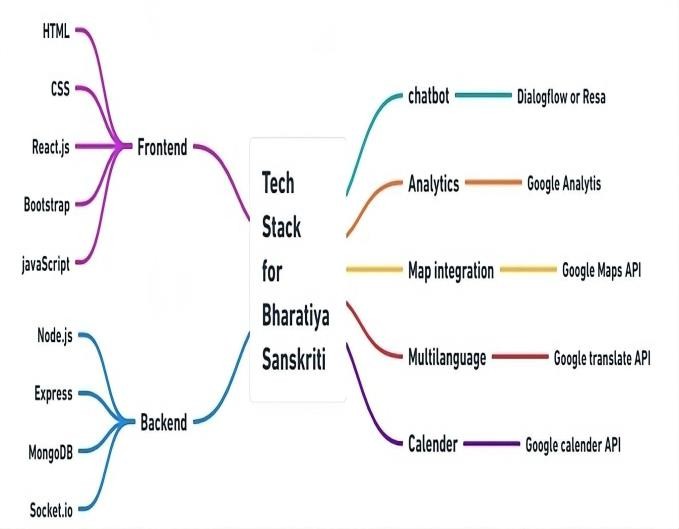
IV. LITERATURE REVIEW
Digital Preservation of Indigenous Culture and Narratives from the Global South: In Search of an Approach byUttaran Dutta. This research papers states the article covers the digital preservation of indigenous cultures in rural eastern India by means of Sangraksha, a digital humanities application. The emphasis is put on the community-driven inclusive methods that help with dealing with the barriers that are like illiteracy, language limits, and digital inexperience. Participatory means such as co-design and visual storytelling, the project enables communities to record and communicate cultural artifacts and oral histories. Sangraksha provides ownership, decolonizes digital spaces, and contributes to the process of bridging the digital divide, ensuring that indigenous voices are included in the global discourse and supporting the sustainable preservation of the cultures.[1]
Digital Preservation of Cultural Heritage: A Case Study of Dev Samaj by Gurpreet Singh Sohal. This research paper states that the study on the requirement of digitizing old manuscripts and books came out as very fundamental for the heritage storage of Dev Samaj, and its 32,000 folios in different languages have been digitized. It discussed the problems which occurred in the processes of digitization and preservation of manuscripts, for example, Lack of Awareness among the young generation, and the creation of a more successful digital library. The paper refers to projects like UNESCO's "Memory of the World" besides Panjab Digital Library, which are problems such as funding, technology, and staffing which need to be addressed.[2]
Sustainable Heritage Management-Need and Challenges by Ramya B.Senthil. This states that Sustainable heritage management is the equilibrium of conserving cultural and natural heritage and the on-going development, which will eventually become a bridge for the rich heritage of India, now being threatened by urbanization, neglect, and climate change. It is carried out through holistic policies, involvement of communities, modern techniques of conservation, and sustainable tourism. HRIDAY schemes come with heritage preservation and accompanying urban development. The Restored Jaisalmer Fort and Ajanta Caves are a good strategy, an excellent example of this. Other good strategies also involve capacity building, legal frameworks, public-private collaboration for maintaining heritage in order to achieve a better tourism sector as well as socio-economic support for the population of tomorrow.[3]
Cultural Heritage Preservation of Traditional Indian Art through Virtual New-media by Saptarshi Kolaya. This research paper states that the rising threat of economic and cultural isolation is jeopardizing the presence of traditional Indian art and craft, which is so integral to the country's cultural heritage. The article calls for the need to apply digital media for the conservation and the revival of these valuable practices. Digital culture is the most effective way to cause an increase in public awareness and to give culture a more open character, which reaches out to more people. Thus, environmental sustainability is the main social issue. The model includes gamified narration, digital documentation, and creative representation strategies. Examples like the Place- Hampi Project and Wrath of Durga show how designer-artisan partnerships may create stories that are both contemporary and genuine. The fundamental core of historic art forms can be preserved and heritage can be effectively connected to the modern world through new media.[4]
The book titled Digital Cultural Heritage Challenges, Solutions, and Future Directions Edited By Vinay Kukreja, Amitoj Singh, Deepinder Kaur, Jagpuneet Kaur Bajwa will look into how new technologies in digital formats revolutionize the preservation, documentation, and archiving of cultural heritage. It examines imaging techniques, metadata management, and high-end tools like virtual and augmented reality in producing immersive and interactive experiences. The book captures expert insights into four domains: Smart Cities and Digital Heritage, Heritage and Education, Culture and Society, and Digital Documentation and Preservation, providing such a wide range for understanding the complex reality of digital cultural heritage. Targeted at engineers, researchers, curators, and educators, the text discusses the intersection of technology within cultural institutions, such as virtual museums, interactive exhibits, and digital storytelling. Here are multimedia interfaces exploring the ways heritage can be interpreted and transformed with great emphasis on a multi-modal delivery that really serves to engage the user. This book highlights innovative strategies that the budding digital heritage field adopts and the transformable potential of digital heritage in education, societal values, and forms of recreation. It combines technical expertise with cultural sensitivity to illuminate the developing role digital technologies have to preserve the global heritage for future generations.[5]
Digital Cultural Heritage Preservation by James Hutson states on how 3D scanning and virtual reality join forces with traditional conservation practices for the protection and enhancement of cultural objects- in-the-long term. It addresses issues such as authenticity, reproduction of sacred and historically significant items in a manner as ethical as possible, and inclusivity in access. Not the least is new initiatives like *"The Game of Culture,* involving using game-based learning and digital interactive platforms to teach and engage the public with culture and history.[6]
Conservation and Management of Indian Built- Heritages: Exploring the Issues and Challenges by Arnab Gantait, Priyakrushna Mohanty, Anjaneya Swamy states that threats posed to India's vast wealth of heritage which constitutes the backbone of cultural identity and economic development, manifest in terms of neglect, encroachment, pollution, and ill-constructed infrastructure. By itself, this heritage has the potentiality for driving tourism and creating socio-economic benefits but has systemic issues at the level of poor awareness, insufficient funding, and low rate-it-internalization in legislation that leads to unsustainability. Besides, challenges include non-comprehensive recognition, lack of community involvement, and improper waste management. Comprehensive emphasis on strengthening public-private partnerships and the framework of law, as well as an improvement of global advocacy, are highly strategic measures. Sustainable tourism practices, local involvement, and mobilization of resources can help mitigate the impact of this degradation. Ultimately, safeguarding India's heritage necessitates multi-stakeholder inputs while balancing preservation with economic development.[7]
Timothy, Gyan P. Nyaupane states that Heritage in India is threatened by various factors such as neglect, encroachment, pollution, and poorly constructed infrastructures. Thus, with the potential to drive tourism and create socio-economic gains, its systemic failings at the level of poor awareness, insufficient funding, and low rate-it-internalization in legislation, lead to unsustainability. Non- comprehensive recognition, lack of community involvement, and unscientific waste management are some of the major challenges. Strategic measures include comprehensive focus on strengthening of public-private partnership and a legal framework as well as improving the further international advocacy. Sustainable tourism practices, local involvement, and mobilization of resources will mitigate the impact of this degradation. In the end, heritage is worth keeping in India through a lot of multi-stakeholder inputs in the balancing preservation and economic development process.[8]
Cultural Heritage and Tourism in the Developing World : A Regional Perspective Edited By Dallen J. Timothy, Gyan P. Nyaupane states that Heritage in India is threatened by various factors such as neglect, encroachment, pollution, and poorly constructed infrastructures. Thus, with the potential to drive tourism and create socio-economic gains, its systemic failings at the level of poor awareness, insufficient funding, and low rate-it-internalization in legislation, lead to unsustainability. Non- comprehensive recognition, lack of community involvement, and unscientific waste management are some of the major challenges. Strategic measures include comprehensive focus on strengthening of public-private partnership and a legal framework as well as improving the further international advocacy.
Sustainable tourism practices, local involvement, and mobilization of resources will mitigate the impact of this degradation. In the end, heritage is worth keeping in India through a lot of multi-stakeholder inputs in the balancing preservation and economic development process.[8]
V. OBJECTIVES
- To showcase India’s cultural diversity by highlighting the diversity of languages, tradition, art, dance forms, music, festivals, cuisines, architecture across India’s regions.
- To preserve India’s folk traditions and endangered cultural practices for future generation.
- By facilitating dialogue and understanding between cultures by sharing stories, experiences, and knowledge about India's traditions with a global audience.
- To engage younger generations through modern, interactive tools like virtual tours, social media.
- To establish India as a global leader in culture, heritage, and spiritual tourism by effectively marketing its unique offerings.
VI. RESEARCH METHODOLOGY
Data was collected from our institute(Ogi) 500 students were selected as respondents and the data was collected from them. For the collection of primary data, a well designed questionnaire was prepared. For secondary data collection various research journals, magazines, newspapers, websites of the respective organizations, etc. were used. After receiving filled questionnaire proper editing was done in respect of completion, relevance, etc.
|
|
Sector |
Distributed |
Received |
|
1 |
Students |
500 |
401 |
|
Area (Students) |
Barriers |
Interest |
Manage ment |
Language |
|
Mean |
73.6 |
90.4 |
72.0 |
84.8 |
|
Median |
74 |
90 |
72 |
84 |
|
Standard Deviation |
13.23 |
11.86 |
14.14 |
12.36 |
|
Skewness |
-0.32 |
0.34 |
-0.21 |
0.07 |
|
Kurtosis |
2.01 |
1.52 |
1.93 |
1.82 |
VII. OBSERVATIONS
- The mean response scores vary across the areas, with interest having the highest average (90.4) and barriers having the lowest (73.6).
- The median values are similar to the means, indicating that the distributions are not heavily skewed.
- The standard deviations are all around 12- 14, suggesting some variability in the responses for each area.
- The skewness values are relatively small, indicating that the distributions are not highly skewed.
- The kurtosis values suggest slightly flatter distributions compared to a normal curve.
- The chi square values for each is given as below:
Barriers = 10.24
Interest= 4.84 Management=7.8 Language=3.24
- The p-value indicates the probability of observing such a difference by chance alone. The p-values for the above data is given as below .
Barriers = 0.006
Interest= 0.089 Management=0.020 Language=0.199.
The chi-square test results show statistically significant differences (p-values < 0.05) in the distribution of responses across the areas. This indicates that the observed pattern (more responses in interest and language compared to barriers and management) is unlikely to be due to chance alone.
Th p-values must be greater than 0.5,
VIII. IMPLEMENTATION
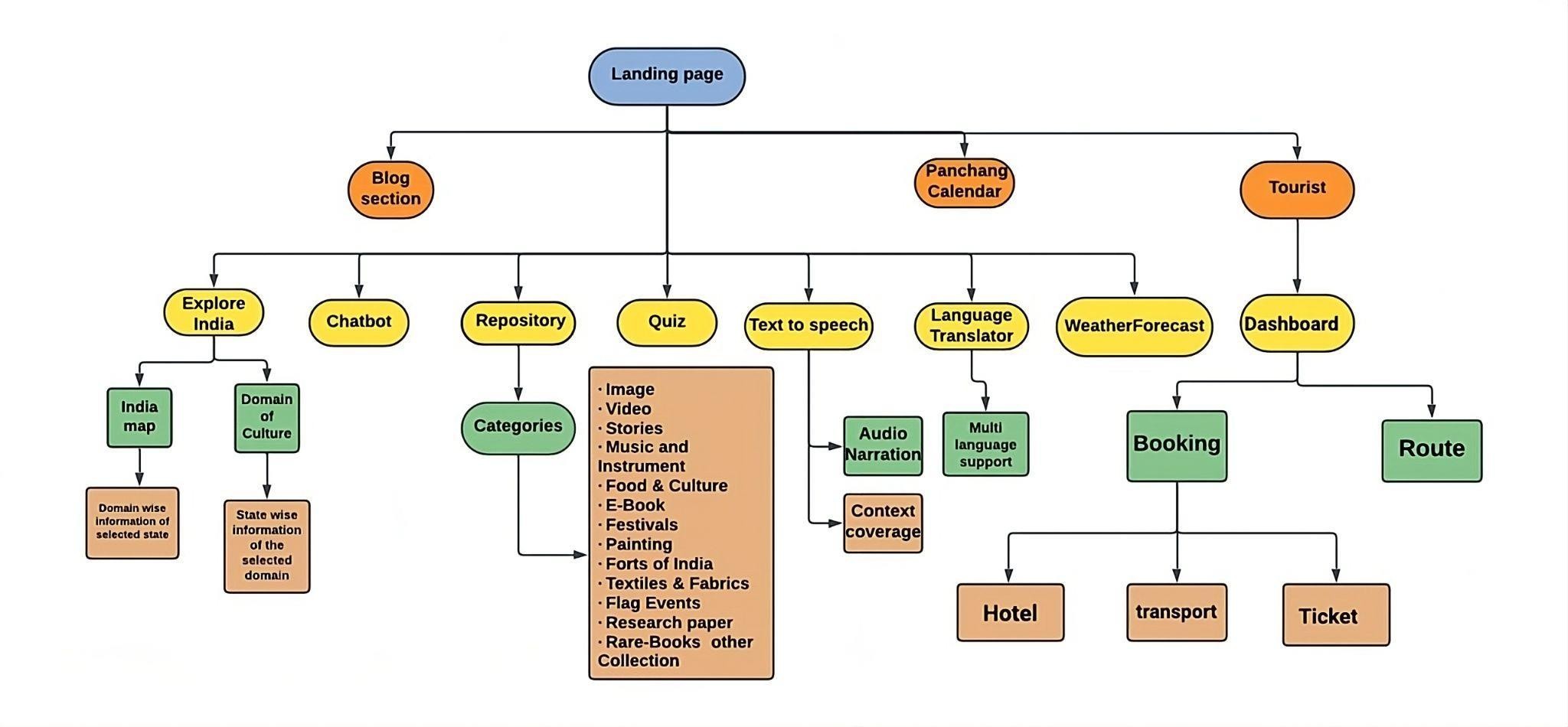
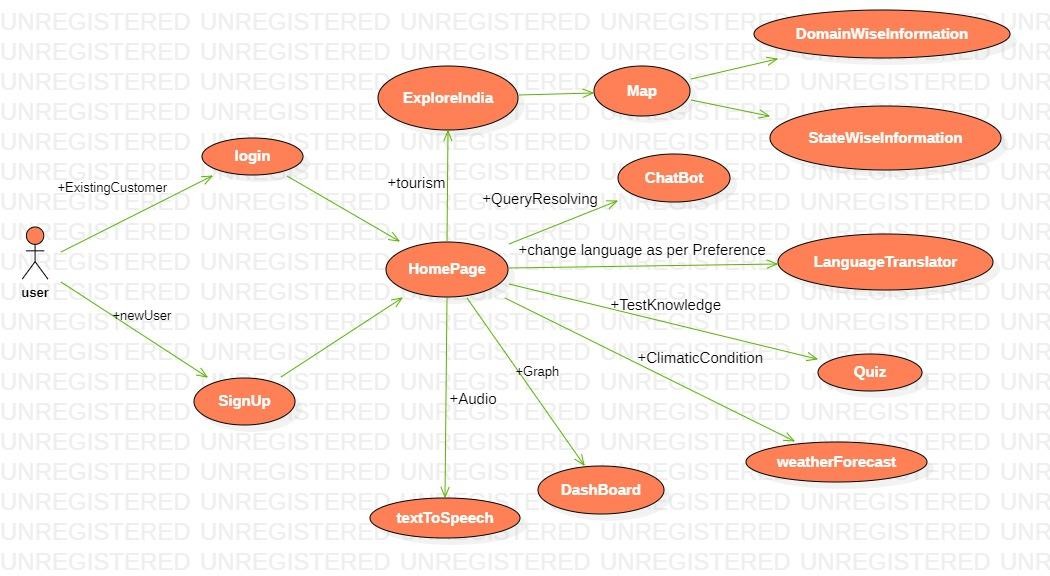
IX, RESULT
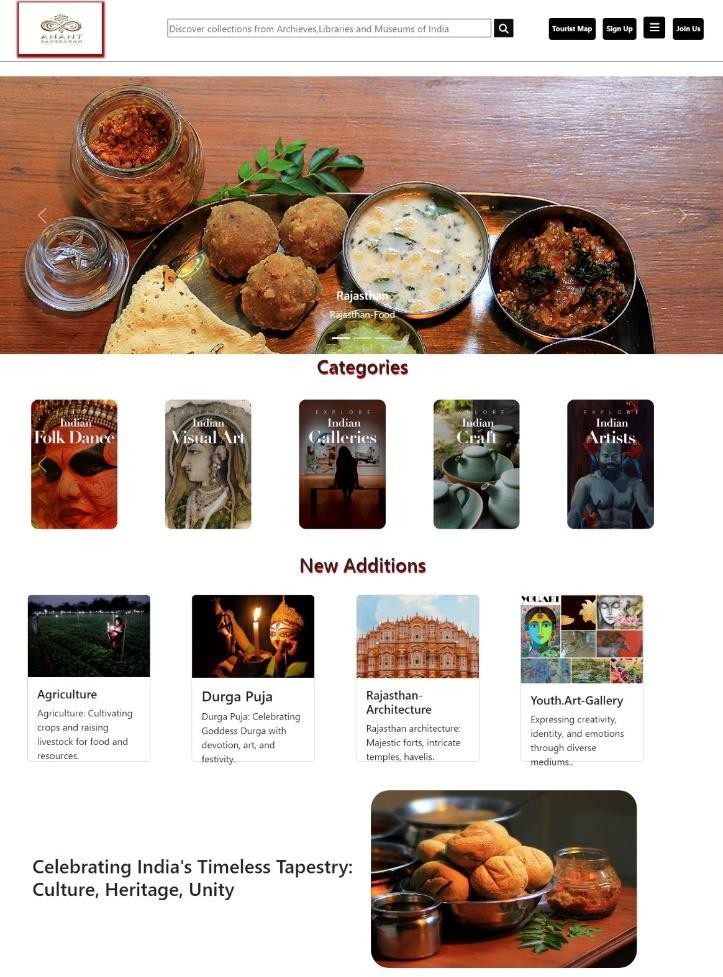
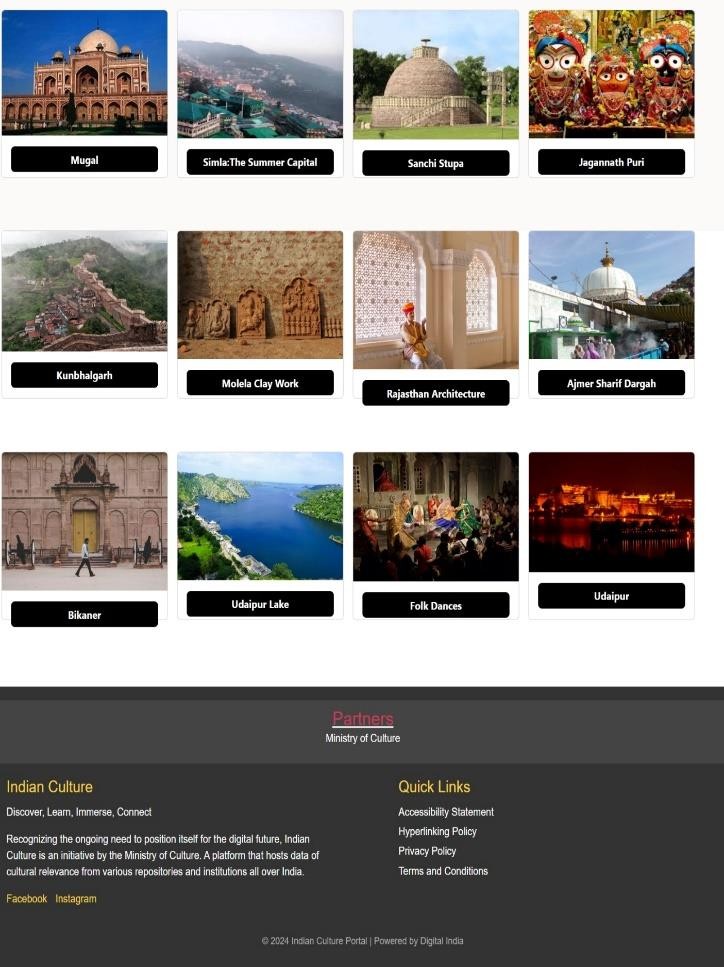
Conclusion
It is concluded that in the face of urbanization, neglect, and no digitization, India needs to preserve and promote its rich cultural heritage. As stated above, we have distributed questionnaires among students of our institution and we have found some areas of difficulties for the students to explore India\'s culture which becomes the inspiration for us to develop a digital platform for displaying and archiving various traditions, arts, and historical artifacts. This platform combines all modern tools, such as AI, interactive maps, virtual tours, and multimedia content, to engage a global audience with India\'s intangible and tangible heritage. It seeks to bridge generational and geographical gaps so that future generations can appreciate and protect India\'s cultural diversity.
References
[1] Dutta, U. Digital Preservation of Indigenous Culture and Narratives from the Global South: In Search of an Approach. Humanities 2019, 8, 68. https://doi.org/10.3390/h8020068 [2] R. B. Senthil, \"Sustainable Heritage Management- Need and Challenges,\" ResearchGate, Dec. 2016, p. 6.[Online]. Available: https://www.researchgate.net/ publication/321194558_Sustainable_Heritage_Mana gement-Need_and_Challenges. [3] G. S. Sohal, \"Digital Preservation of Cultural Heritage: A Case Study of Dev Samaj,\" ResearchGate, 2017, p. 5.[Online]. Available: https://www.researchgate.net/ publication/321212313_Digital_Preservation_of_Cul tural_Heritage_A_Case_Study_of_Dev_Samaj [4] Hutson, James, \"Digital Cultural Heritage Preservation\" (2024). Faculty Scholarship. 662.https://digitalcommons.lindenwood.edu/faculty-research-papers/662Published 8-2024 [5] S. Kolay, \"Cultural Heritage Preservation of Traditional Indian Art through Virtual New-media,\" 2015,p.11.[Online].Available: https://doi.org/10.1016/j.sbspro.2016.06.030. [6] V. Kukreja, A. Singh, D. Kaur, and J. K. Bajwa, Digital Cultural Heritage: Challenges, Solutions, and Future Directions, 1st ed., Boca Raton: CRC Press, 2024, p. 258. https://doi.org/10.1201/9781032630564. [7] A. Gantait, P. Mohanty, and G. A. Swamy, \"Conservation and Management of Indian Built Heritages: Exploring the Issues and Challenges,\" South Asian Journal of Tourism and Heritage, vol. 11, no. 1, pp. 5–21, Jan. 2018. https://ssrn.com/abstract=4016570. [8] Olsen, D. H. (2010). Cultural heritage and tourism in the developing world: a regional perspective. Journal of Heritage Tourism, 5(3), 251–252. https://doi.org/10.1080/17438731003737539
Copyright
Copyright © 2024 Ms. Shivangi Sharma, Ankit Pandey, Mukul Dubey, Shivam Amarghade, Shrut Jain, Namira Qureshi, Nancy Tripathi. This is an open access article distributed under the Creative Commons Attribution License, which permits unrestricted use, distribution, and reproduction in any medium, provided the original work is properly cited.

Download Paper
Paper Id : IJRASET65952
Publish Date : 2024-12-16
ISSN : 2321-9653
Publisher Name : IJRASET
DOI Link : Click Here
 Submit Paper Online
Submit Paper Online

